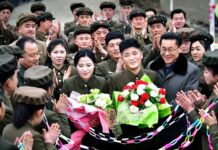Food shortages in the North Korean agricultural heartland of Hwanghae Province are leading to starvation deaths, Daily NK has learned. A significant percentage of cooperative farm workers are reportedly too malnourished to work, and a number are leaving their farms to seek help.
A North Hwanghae Province source told the Daily NK in recent days, “Local people are in pain from hunger, but the only help that households short of food are receiving from the authorities is 1 or 2 kg of corn; it’s emergency relief but only sufficient to stop them starving. Seeing the situation getting worse and with help from the authorities being so inadequate, there are people leaving for other areas to get help from family.”
The source gave an example of one village, saying, “Hangae-ri in Shingye County alone has seen a total of six children and elderly people die of starvation. At the same time, all the authorities are doing is telling everyone to try and overcome the difficulties.”
A second resident of the area, this time from South Hwanghae Province, recently came out into the North Korea-China border region to get food. Speaking with Daily NK by phone, the source mirrored the same sentiment, painting an alarming picture of the late winter food situation in and around Haeju, a coastal city just a few kilometers from South Korean Yeonpyeong Island.
“A few dozen very weak people could be found on each farm,” the source explained. “The farms put in place measures to deal with it, but these were fairly useless. By the time April had passed, something like ten people had died of starvation on each farm.”
“Food shortages were so serious that the 1st and 2nd Corps patrolling the military demarcation line around Kaesong were malnourished,” the source went on, adding that many of the soldiers from those units are now doing farming themselves because farm workers are deserting their posts.
There are three main reasons for the widespread food insecurity in North and South Hwanghae Province in recent months. First, production in 2011 fell locally due to flooding; second, military units charged with procuring supplies from farms sent most of the autumn harvest to military stores or for public distribution in Pyongyang. Finally, during the 100-day mourning period for Kim Jong Il (December 17th-March 25th) market trading was disrupted, removing the food safety net that has helped North Korea to avoid famine repeatedly in recent years.
Market trading was initially forbidden in this period, and although markets did soon reopen on the orders of Kim Jong Eun, the source said that since only people who hold a specific entry permit can enter militarily sensitive South Hwanghae and Gangwon Province, “the Haeju area got cut off because it was impossible to obtain a travel permit.”
As food insecurity worsened, people reportedly urged officials to help, but violating Party decrees during the mourning period was seen as more than their life was worth.
Tokyo Shinmun reported in mid April that 20,000 people had died of starvation in three counties in South Hwanghae Province; Baechon, Yeonan and Chungdan. Though information about inaccessible and sparsely populated Gangwon Province is limited, it seems unlikely that the area could avoid cases of starvation entirely.
Ishimaru Jiro, the director of ASIAPRESS, an organization that fosters journalists in North Korea and has contacts in Haeju, commented to Daily NK, “There is a constant flow of testimony to the fact that food shortages in Hwanghae Province are serious. We should keep in mind that things are not simply hard; there are actually people dying of starvation.”



















